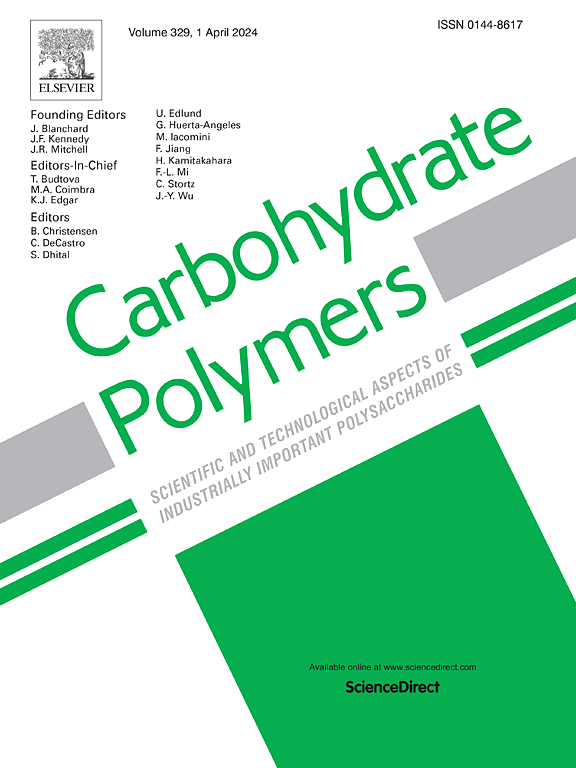Hydrophobic associations and cellulose nanofibers reinforced PVA/PAM multi-network conductive hydrogel with high sensitivity, fast response, and excellent mechanical properties
IF 12.5
1区 化学
Q1 CHEMISTRY, APPLIED
引用次数: 0
Abstract
With the growing demand for green and biocompatible flexible sensors, hydrogels have drawn attention as a new material for flexible wearable devices. However, it remains a challenge to develop hydrogel flexible sensors with excellent mechanical properties, high toughness, high sensitivity and fast response through a simple approach. In this work, hydrophobic associations and cellulose nanofibers were introduced into a polyacrylamide/polyvinyl alcohol (PAM/PVA) dual-network hydrogel. The incorporation of a hydrophobic system strengthens the first polymer network, while cellulose nanofibers (CNF) enhance the second PVA freeze-thaw network. Notably, CNF tightly bridges the dual networks, forming extensive hydrogen bonds with the reinforced double-network structure. Under the synergistic effects of multiple networks and hydrogen bonding interactions, the composite hydrogel exhibits superior mechanical performance (1.82 MPa), outstanding toughness (5.41 MJ/m3), excellent fatigue resistance, and good recovery properties. Additionally, the composite hydrogel demonstrates superior electrical conductivity, high sensitivity (GF = 7.89), and stable electrical signal output. It performs exceptionally well in practical applications, such as monitoring motion at human joints and integrating with peripheral circuits to control robotic hands. In summary, this work presents a simple and cost-effective method for fabricating high-performance composite hydrogels, which show great potential in tissue engineering, flexible electronics, and human-computer interaction.

疏水缔合物和纤维素纳米纤维增强PVA/PAM多网导电水凝胶具有高灵敏度、快速响应和优异的力学性能
随着人们对绿色和生物相容性柔性传感器的需求日益增长,水凝胶作为一种柔性可穿戴设备的新材料受到了人们的关注。然而,如何通过简单的方法开发出具有优异力学性能、高韧性、高灵敏度和快速响应的水凝胶柔性传感器仍然是一个挑战。本研究将疏水缔合物和纤维素纳米纤维引入聚丙烯酰胺/聚乙烯醇(PAM/PVA)双网状水凝胶中。疏水系统的加入增强了第一个聚合物网络,而纤维素纳米纤维(CNF)增强了第二个聚乙烯醇冻融网络。值得注意的是,CNF紧密桥接双网络,形成广泛的氢键与增强的双网络结构。在多个网络和氢键相互作用的协同作用下,复合水凝胶表现出优异的力学性能(1.82 MPa)、优异的韧性(5.41 MJ/m3)、优异的抗疲劳性能和良好的恢复性能。此外,复合水凝胶具有优异的导电性、高灵敏度(GF = 7.89)和稳定的电信号输出。它在实际应用中表现出色,例如监测人体关节的运动,并与外围电路集成以控制机械手。总之,这项工作提出了一种简单而经济的制备高性能复合水凝胶的方法,在组织工程、柔性电子和人机交互方面具有很大的潜力。
本文章由计算机程序翻译,如有差异,请以英文原文为准。
求助全文
约1分钟内获得全文
求助全文
来源期刊

Carbohydrate Polymers
化学-高分子科学
CiteScore
22.40
自引率
8.00%
发文量
1286
审稿时长
47 days
期刊介绍:
Carbohydrate Polymers stands as a prominent journal in the glycoscience field, dedicated to exploring and harnessing the potential of polysaccharides with applications spanning bioenergy, bioplastics, biomaterials, biorefining, chemistry, drug delivery, food, health, nanotechnology, packaging, paper, pharmaceuticals, medicine, oil recovery, textiles, tissue engineering, wood, and various aspects of glycoscience.
The journal emphasizes the central role of well-characterized carbohydrate polymers, highlighting their significance as the primary focus rather than a peripheral topic. Each paper must prominently feature at least one named carbohydrate polymer, evident in both citation and title, with a commitment to innovative research that advances scientific knowledge.
 求助内容:
求助内容: 应助结果提醒方式:
应助结果提醒方式:


